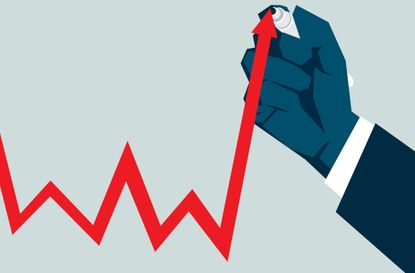Kiplinger's Inflation Outlook: Rising Prices To Ease Soon
Inflation will drop in the next few months, but price pressures remain in the services sector.
- (opens in new tab)
- (opens in new tab)
- (opens in new tab)
- Newsletter sign up Newsletter


Kiplinger’s Economic Outlooks are written by the staff of our weekly Kiplinger Letter and are unavailable elsewhere. Click here for a free issue of The Kiplinger Letter or for more information.
There were signs of improvement in the April consumer price index (CPI) report.
The inflation rate edged down to a still-high 4.9% in April and should drop to around 3.5% in the next few months. Much of the decline will happen because big price increases a year ago will no longer be in the calculation, but some of the slowdown in inflation will be because of easing price pressures showing up now. Shelter prices, the biggest single component in the index, slowed their rate of increase in April to 0.4%, from 0.8% in March, and are expected to slow further over the coming months. The prices of other services slowed significantly, to 0.1%. This is the so-called “core services” component that the Federal Reserve is focused on.

Sign up for Kiplinger’s Free E-Newsletters
Profit and prosper with the best of expert advice on investing, taxes, retirement, personal finance and more - straight to your e-mail.
Profit and prosper with the best of expert advice - straight to your e-mail.
Grocery prices are starting to reverse their previous spike, declining modestly in April for the second month. Meat prices edged down, and egg prices have fallen about 19% over the past three months. Price increases at restaurants eased for the first time this year, indicating that consumer resistance to rising menu prices may be mounting. Though gasoline prices rose, other energy prices declined, and energy prices in general seem to be on a meandering trend.
April inflation would have been lower if not for a surprise jump in used car and truck prices. However, this trend is already beginning to turn around. New vehicle prices edged down in April, the first decrease in two years.
Signs of inflation moderating should enable the Federal Reserve to pause its campaign of hiking short-term interest rates at its next policy meeting on June 14. Concerns about depositor confidence in certain regional banks will be the main reason for the pause, but the April inflation report will make the decision easier.
Yet, the Fed will remain concerned about persistent inflation in the services sector, which will likely keep it from cutting rates this year, unless a recession hits. The Fed would like to see wage increases start to soften in order to prevent a cycle of further price increases, with businesses trying to maintain their profit margins by passing higher wage costs along to customers.
Related content
- Kiplinger's Economic Outlooks
- When is the next Fed meeting
- How inflation can impact your taxes
- Is inflation costing you more as a retiree?

David is both staff economist and reporter for The Kiplinger Letter, overseeing Kiplinger forecasts for the U.S. and world economies. Previously, he was senior principal economist in the Center for Forecasting and Modeling at IHS/GlobalInsight, and an economist in the Chief Economist's Office of the U.S. Department of Commerce. David has co-written weekly reports on economic conditions since 1992, and has forecasted GDP and its components since 1995, beating the Blue Chip Indicators forecasts two-thirds of the time. David is a Certified Business Economist as recognized by the National Association for Business Economics. He has two master's degrees and is ABD in economics from the University of North Carolina at Chapel Hill.
-
-
 Spending Cuts Could Trigger Deeper Slowdown: Kiplinger Economic Forecasts
Spending Cuts Could Trigger Deeper Slowdown: Kiplinger Economic ForecastsEconomic Forecasts Spending Cuts Could Trigger Deeper Slowdown: Kiplinger Economic Forecasts
By David Payne • Published
-
 Travel Demand and Delays to Soar, So Plan Ahead: Kiplinger Economic Forecasts
Travel Demand and Delays to Soar, So Plan Ahead: Kiplinger Economic ForecastsEconomic Forecasts Travel Demand and Delays to Soar, So Plan Ahead: Kiplinger Economic Forecasts
By Sean Lengell • Published
-
 Spending Cuts Could Trigger Deeper Slowdown: Kiplinger Economic Forecasts
Spending Cuts Could Trigger Deeper Slowdown: Kiplinger Economic ForecastsEconomic Forecasts Spending Cuts Could Trigger Deeper Slowdown: Kiplinger Economic Forecasts
By David Payne • Published
-
 SpaceX in Good Shape Despite Test Flight: Kiplinger Economic Forecasts
SpaceX in Good Shape Despite Test Flight: Kiplinger Economic ForecastsEconomic Forecasts SpaceX in good shape despite test flight concerns: Kiplinger Economic Forecasts.
By John Miley • Published
-
 Virgin Orbit Failure Casts Cloud Over Space Voyages: Kiplinger Economic Forecasts
Virgin Orbit Failure Casts Cloud Over Space Voyages: Kiplinger Economic ForecastsEconomic Forecasts Virgin Orbit failure casts a cloud over space voyages but SpaceX could fill the void.
By Letter Editors • Published
-
 TikTok Ban Winners and Social Media Changes: Kiplinger Economic Forecasts
TikTok Ban Winners and Social Media Changes: Kiplinger Economic ForecastsEconomic Forecasts TikTok Ban winners, LinkedIn changes: Kiplinger's analysis of the massive social media cross-platform shake-ups.
By Letter Editors • Published
-
 Shortage of electrical engineers to power labor market growth: Kiplinger Economic Forecasts
Shortage of electrical engineers to power labor market growth: Kiplinger Economic ForecastsEconomic Forecasts A lack of skilled graduates and funding are contributing to the shortage.
By David Payne • Published
-
 AI Regulation is Looming: Kiplinger Economic Forecasts
AI Regulation is Looming: Kiplinger Economic ForecastsEconomic Forecasts Find out what Washington and regulators have planned for artificial intelligence.
By John Miley • Published
-
 Kiplinger's Retail Outlook: Consumers Are Still Resilient
Kiplinger's Retail Outlook: Consumers Are Still ResilientEconomic Forecasts Kiplinger's Retail Outlook: Sales this year are likely to be mostly stable, even as the economy slows.
By David Payne • Last updated
-
 Kiplinger's Trade Outlook: U.S. Trade Deficit Narrowed Sharply in March
Kiplinger's Trade Outlook: U.S. Trade Deficit Narrowed Sharply in MarchEconomic Forecasts Exports won’t provide much boost to U.S. GDP this year.
By Rodrigo Sermeño • Last updated








